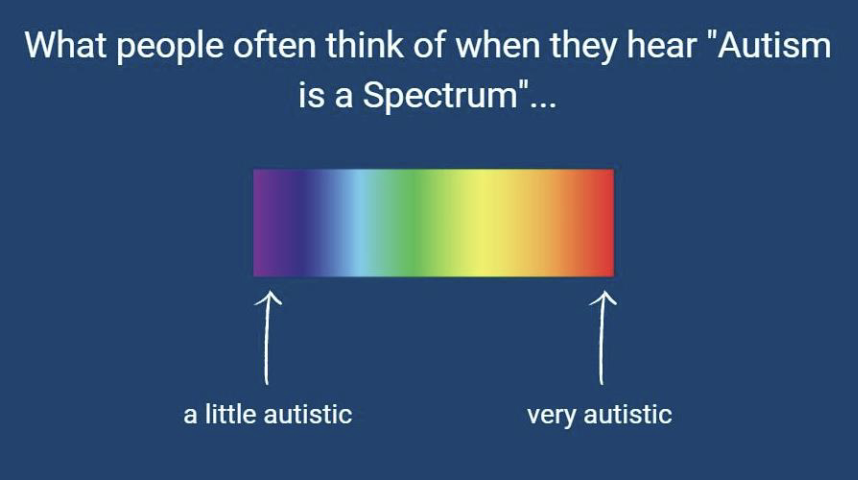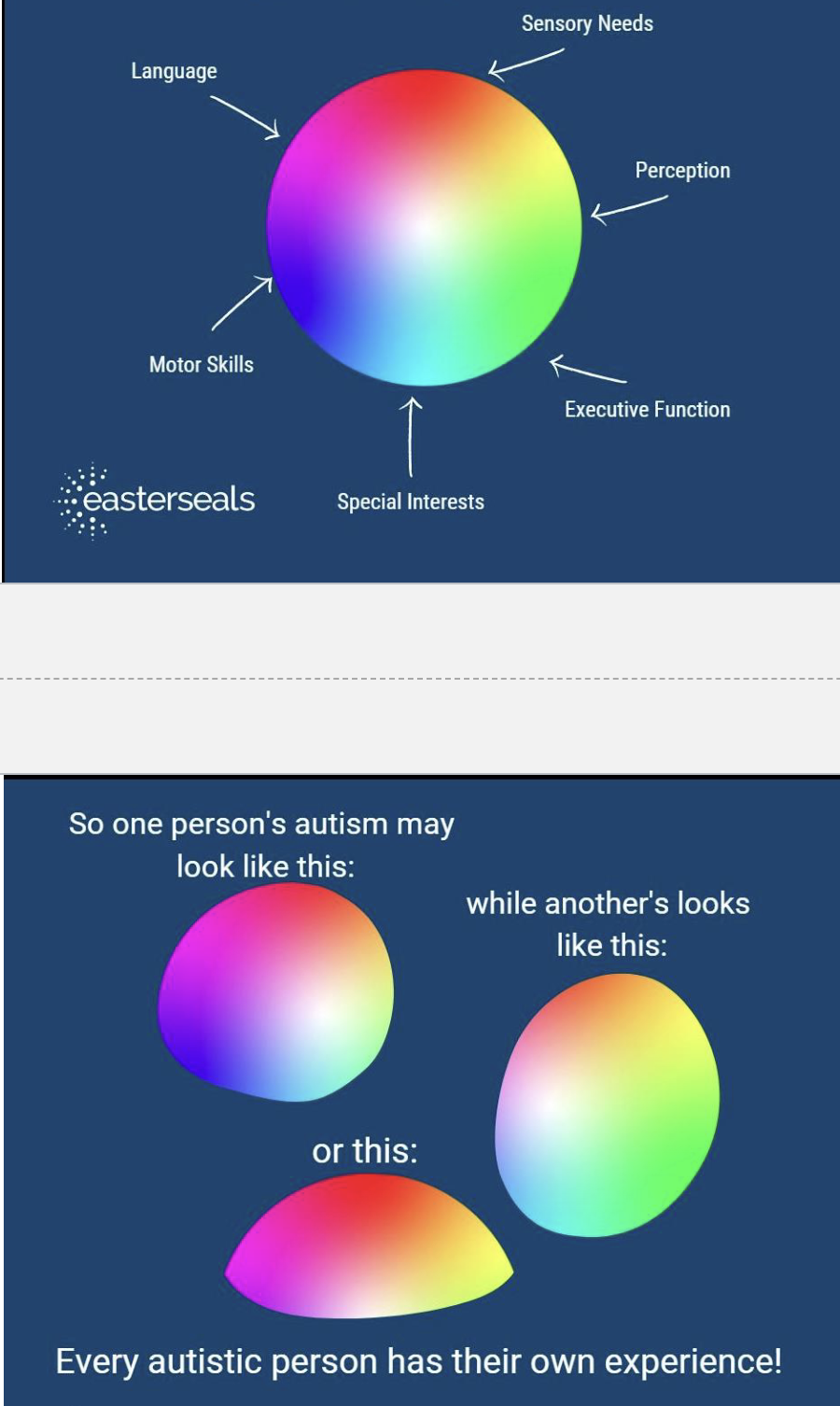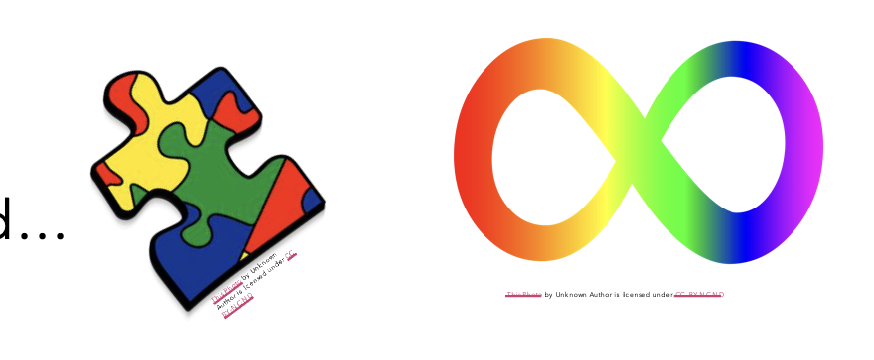wk 1: intro to social communication disorders
1/20
There's no tags or description
Looks like no tags are added yet.
Name | Mastery | Learn | Test | Matching | Spaced |
|---|
No study sessions yet.
21 Terms
what the spectrum is really like: (what are the differences or behaviors?)
sensory differences
language differences
repetitive behaviors
social differences

this is not an accurate portrayal of the autistic experience
Autism is NOT linear
what does a more realistic depiction of the autism spectrum?

person first vs identity first language
person first: a child with autism
identity first: autistic child
we now use identity-first language in the Autistic community, unless the person says otherwise
symbols (puzzle piece vs infinity symbol)
we are moving away from the puzzle piece (they have something missing) and towards the infinity symbol

Who Can Diagnose Autism? (depends on the state)
Developmental Pediatricians
Child Psychologists
Child Psychiatrists
Pediatric Neurologists
Pediatricians- TX (any)
Neurologists- TX
Other Physicians- TX
School Psychologists- TX
SLPs can in their scope of practice but insurance does not recognize our dx
what is DSM-5?
The Diagnostic and Statistical Manual of Mental Disorders
A reference book on mental health and brain-related conditions and disorders
DSM-I (1952) –
DSM-II (1968) –
DSM-III (1980) –
DSM-IV (1994) –
DSM-V (2013) --
no autism classification
autism classified under schizophrenia
“infantile autism” listed as a separate diagnosis from schizophrenia
revised diagnostic criteria with 5 subtypes of autism
autism spectrum disorder (ASD) redefined as a single disorder with 3 levels; added social communication disorder (SCD)
DSM-IV-TR Possible Diagnosis vs DSM 5
DSM-IV: Autism spectrum disorders with pervasive developmental disorder-not otherwise specified (PDD-NOS), autistic disorder, Asperger disorder, childhood disintegrative disorder
DSM 5- Autism spectrum is the sole diagnosis
DSM-IV-TR vs DSM 5 Diagnostic criteria for ASD
DSM-IV: must meet two of the social and one of the communication criteria
DSM 5: Deficits in social communication/interaction (must meet all three of the social criteria)
Restricted and repetitive interests (must meet two of the four behavior criteria)
DSM-5 Possible co-occurring diagnosis
Attention-deficit/hyperactivity disorder; speech sound disorder, language disorder, childhood-onset fluency disorder; social (pragmatic) communication disorder NOT social (pragmatic) communication disorder
shows how ASD is NOT the same as social communication disorder
DSM-5 severity levels
Level 3: Requiring very substantial support
Level 2: Requiring substantial support
Level 1: Requiring support
*this is very subjective
Persistent deficits in each of the __ areas (name these areas) of social communication plus at least __ types of restricted, repetitive behaviors
3; 2-4
Social-emotional reprocitiy: Trouble with social back-and-forth, not knowing how to start or keep a conversation going, not sharing interests or feelings, or not responding to others in social situations.
Problems with nonverbal communication: This can include using words and body language that don’t match, avoiding eye contact, not understanding gestures, or not using facial expressions or other nonverbal cues.
Difficulty with relationships: This includes struggling to change behavior depending on the social situation, having trouble playing or making friends, or showing little interest in other people
all three have to be present
what are the 2-4 types of restricted, repetitive behaviors
Repetitive motor actions, use of objects, or speech: This includes repeated body movements (like hand-flapping), lining up toys, repeating words or phrases (echolalia), or using unusual expressions.
Strong need for routines: This means getting very upset with small changes, having a hard time with transitions, insisting on doing things the same way (like always taking the same route or eating the same food), or using set ways to greet people.
Intense or unusual interests: This refers to being extremely focused on specific topics or objects, often in a way that seems unusual or overly intense.
Unusual (hyper or hypo) responses to sensory input: This includes being very sensitive or not sensitive enough to things like sounds, textures, or temperature, or showing strong interest in sensory details (like staring at lights or touching objects often).
Here’s a short list for Autistic traits, redefined from a deficit/symptomatic mindset:
Deficit: Autistics have abnormal social approaches
Redefined: We socialize differently and often find socializing with one another easier than socializing with non-autistics
Here’s a short list for Autistic traits, redefined from a deficit/symptomatic mindset:
Deficit: Autistics take part in restrictive, repetitive movements
Redefined: We take part in stimming in order to self-regulate, communicate our needs, and express emotions
Here’s a short list for Autistic traits, redefined from a deficit/symptomatic mindset:
Deficit: Autistics insist on sameness and have strict routines
Redefined: In order to cope with the chaos of unsupportive environments, we ground ourselves in comforting routines
Here’s a short list for Autistic traits, redefined from a deficit/symptomatic mindset:
Deficit: Autistics engage in highly restrictive interests with abnormal intensity.
Redefined: We are drawn to specific passions that bring us joy, help us self-regulate, foster connections with others, and allow us to process the world around us.
Here’s a short list for Autistic traits, redefined from a deficit/symptomatic mindset:
Deficit: Autistics are aversive to sensory input or have excessive interest in sensory input.
Redefined: We perceive our world through details instead of the big picture, and as such we are affected by the impact of sensory details – some of which we are sensitive to or attracted to
neurodiversity movement
Individual brain differences are part of the expected variation
Neurotypical brains are not “normal”
Neurodivergent brains are not “broken”
Focuses on inclusion, accommodations and support
Not trying to find a cure
Social Pragmatic/Communication Disorder (SCD)
Recent addition to the DSM-5
Rule out ASD first
Persistent difficulties using verbal and nonverbal communication cues across several contexts
Communication difficulties
Delayed milestones at an early age
Challenges unrelated to other medical or language difficulty (i.e., not intellectual disability)
NOT have the repetitive/restricted behaviors (MAIN DIFFERENCE)